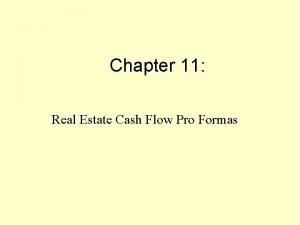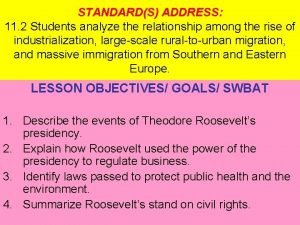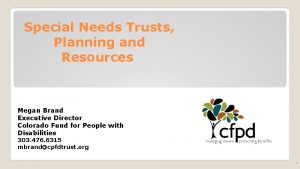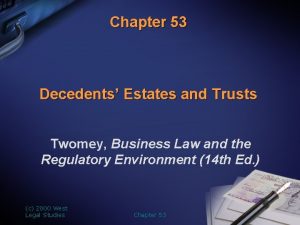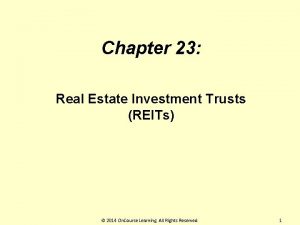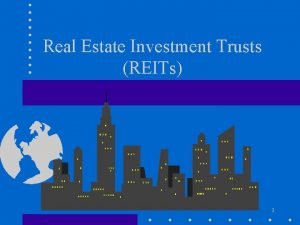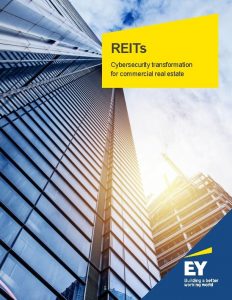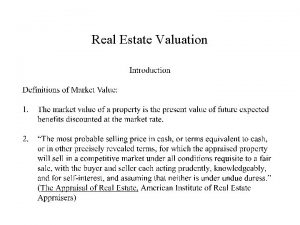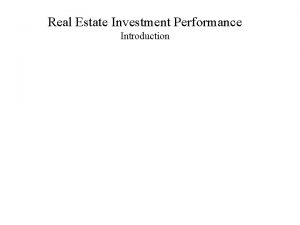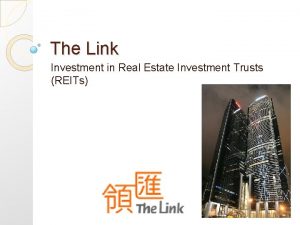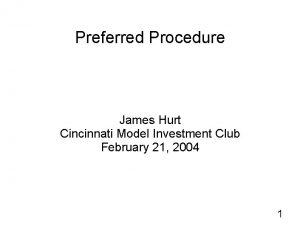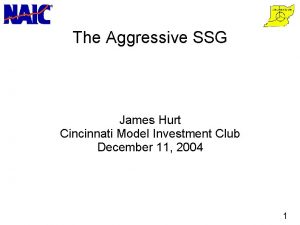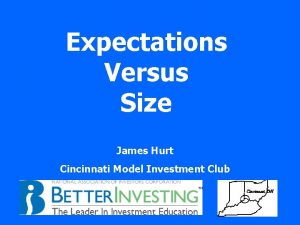REITs Real Estate Investment Trusts James Hurt Cincinnati















- Slides: 15

REITs Real Estate Investment Trusts James Hurt Cincinnati Model Club April 2004 (from material provided by Herb Barnett, Director, NAIC Computer Group)

Definition of REIT • Corporation or business trust • Must pay out 90% of its net income to shareholders • Exempt from Federal Taxes

REITs • Business is to buy (and sell), manage, and maintain real estate for rent or lease • May specialize in one kind of real estate or diversify with different kinds of property • May be in one region of the country or in various parts of country

Categories of REITs • • • Apartments office buildings industrial properties shopping malls outlet malls storage facilities

Investment Characteristics • Moderate growth potential • Income stocks – Dividend is a large portion of the Total Return • Low correlation between REITs and the broader market • High debt levels - 50 to 70% not uncommon

Kimco Realty Corp. Moderate Growth

Kimco Realty Corp. High Payout Ratio and High Yield

Investment Characteristics • We are investing in the real estate property and in management capabilities of the REIT • Self-managed REITs tend to provide better total return and liquidity with less risk

Potential Problems • Sensitive to outside economic forces – Interest rate changes – Health of the economy – Demographic changes • Sensitive to the Real Estate Cycle – Each segment has its own cyclical pattern

Slide produced by Herb Barnett, NAIC Computer Group Reduced Capacity Demand Less Construction Tight R. E. Market Rent Increases Real Estate Cycle Increased Profits Reduced Profits Pressure on Rents Supply Over-building Excess Capacity Renter’s Market

Data Entry using V. L. • For Total Revenue (Sales) add Rental Income and Other Income • Instead of EPS use Funds from Operations (FFO) per share • For the Tax Rate enter 0. • Do not use the V. L. Quarterly Data.

Value Line Data you should use

FFO per share Rental Income + Other Income 0% Tax Rate

OPS Data • For Revenues OPS uses Interest Income + Non-Interest Income. • OPS uses EPS instead of FFO for Per Share Data. • OPS does provide Quarterly Data (Revenues and EPS) for PERT.

Next Month • Will discuss – More about Investment Concerns – Quarterly Data – FFO vs. EPS
 Denver real estate investment association
Denver real estate investment association Cash flow pro
Cash flow pro 11245 lantern road fishers in 46038
11245 lantern road fishers in 46038 Fixed investment and inventory investment
Fixed investment and inventory investment What steps did roosevelt take to solve trusts
What steps did roosevelt take to solve trusts Why are the trusts portrayed as vultures
Why are the trusts portrayed as vultures The principal message of this cartoon is that standard oil
The principal message of this cartoon is that standard oil Industrialists of the late 1800s used pools and trusts to
Industrialists of the late 1800s used pools and trusts to Content filtering trusts
Content filtering trusts Colorado special needs trust
Colorado special needs trust Ap shah moodle
Ap shah moodle History of equity and trusts
History of equity and trusts Neville estates ltd v madden
Neville estates ltd v madden Charitable trust equity law
Charitable trust equity law Development trusts ni
Development trusts ni 53 trusts
53 trusts

